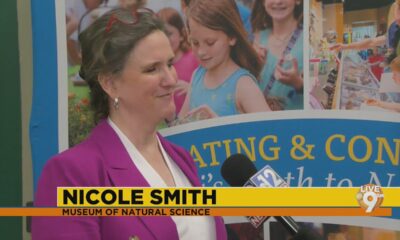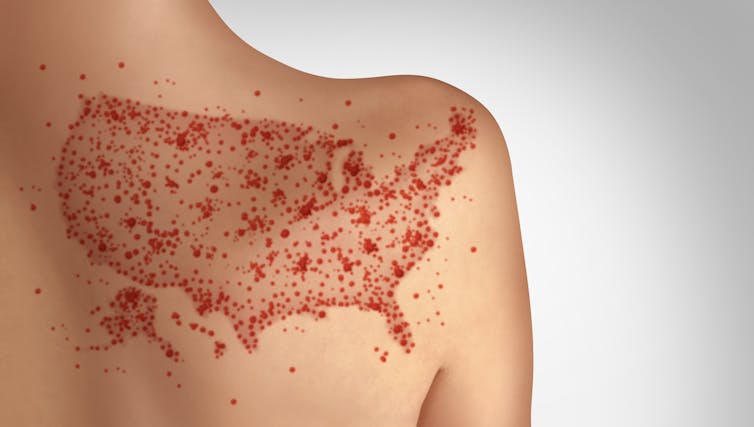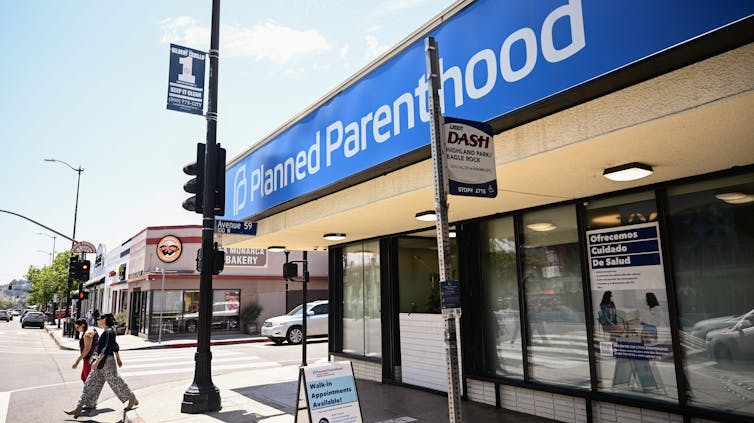
Photo by John Moore/Getty Images
William McCorkle, College of Charleston
Donald Trump’s anti-immigrant rhetoric has been a staple of his political career, but his attacks on undocumented migrants turned more ominous during his 2024 presidential campaign.
Beyond disparaging Haitians living in Springfield, Ohio, Trump in September compared undocumented immigration with a “military invasion.” And on a radio program in early October, Trump said immigrant criminals have “bad genes.”
Many Americans want a more secure U.S.-Mexico border specifically and stricter immigration policy in general.
But a recent national survey I conducted with several immigration scholars found that many Americans would not stop there. Many respondents said violence would be justified to stop immigrants from entering the United States.
Violence against migrants
Our survey, conducted in July 2024, asked 2,042 participants with varied racial and political backgrounds several questions regarding the use of violence against U.S. immigrants.
One question asked whether they thought the U.S. government “should be allowed to use violence to halt unauthorized immigration.”
Only 26% of participants agreed with the idea. But acceptance increased to 47% among respondents who identified as conservative and to nearly 54% among those who identified as extremely conservative.
We also asked whether “individuals should be allowed to use violence to stop unauthorized immigration.”
Though only 11% of the overall participants agreed, 21% of those who identified as conservative and 41% of those who identified as extremely conservative thought vigilante violence against migrants was justified.

AP Photo/Eric Gay, File
Finally, in a question based on some incendiary comments made by Texas Gov. Greg Abbott, we asked whether “the state of Texas should be allowed to shoot migrants who crossed the border without authorization.”
In January 2024, Abbot had implied that Texas would be open to the idea of shooting those crossing illegally if state officers would not be prosecuted by the federal government.
Among the broader sample, only 12% agreed that Texas should be allowed to shoot border-crossers on sight. However, 24% of conservatives agreed with that statement, while 52% of extremely conservative respondents agreed.
Our survey makes clear that a majority of Americans do not agree with using violence against migrants.
Yet, it surprised us that among certain sectors of the country, more than half of the people surveyed said migrants can and perhaps should be shot simply for unauthorized migration.
From ideas to action
Scapegoating immigrants may be a politically advantageous strategy, but such rhetoric can have tragic implications.
A 2014 study found that a political advertisement with mild violent metaphors was associated with higher support for political violence, especially among young participants. These findings point to a troubling way that violent rhetoric can eventually increase violent attitudes among a portion of the population.
In March, I traveled along the entire 808-mile Texas-Mexico border from Brownsville to El Paso. At the end of the four-day trip, I visited the Walmart in El Paso where a young man who espoused white supremacist views killed 23 people in August 2019.
In an online manifesto, written before the attack, the attacker said he was targeting the “Hispanic invasion of Texas.” This group, he added, would allow the “pro open borders, free healthcare for illegals” Democratic Party to rule the country.
In many ways, the shooter’s language echoed the rhetoric of Trump, who was president at the time.

MARK RALSTON/AFP via Getty Images
During his 2015 presidential campaign, Trump had frequently referred to immigration as a dangerous foreign invasion.
In a July post on social media, he warned of “THE INVASION OF MILLIONS OF ILLEGALS TKING OVER AMERICA!” That same year, his campaign team wrote on Facebook, “It’s CRITICAL that we STOP THE INVASION.”
In July 2018, he talked about the “infestation” of violent migrants coming into the country. In November of that same year, he warned that Democrats “want America to be a giant sanctuary city for drug dealers, predators and bloodthirsty MS-13 killers” – a reference to an international gang formed by Salvadoran immigrants.
Some Trump supporters have embraced this kind of aggressive anti-immigrant stance.
At a Florida campaign rally Trump held in May 2019, a participant said the government should shoot migrants. Instead of condemning the idea, Trump joked that they could only get away with that statement in the Panhandle.
I fear that a second Trump presidency full of violent, anti-immigrant rhetoric could drive more bloodshed.
As Amy Cooter, who studies extremism, points out, several militias with hostile attitudes about illegal immigration stand ready to engage in deportation and border security efforts.
She points to the example of two militia members found guilty of conspiracy to murder officers and employees of the U.S. government. They had plotted to shoot undocumented immigrants at the border – and planned to kill any Border Patrol officials who attempted to stop them.
Hostility toward immigrants is not new. But in the current political environment, my research suggests that another four years under Trump may lead to more anti-immigrant rhetoric. That, in turn, could foment more anti-immigrant attitudes and possibly violence.![]()
William McCorkle, Assistant Professor of Education, College of Charleston
This article is republished from The Conversation under a Creative Commons license. Read the original article.























































